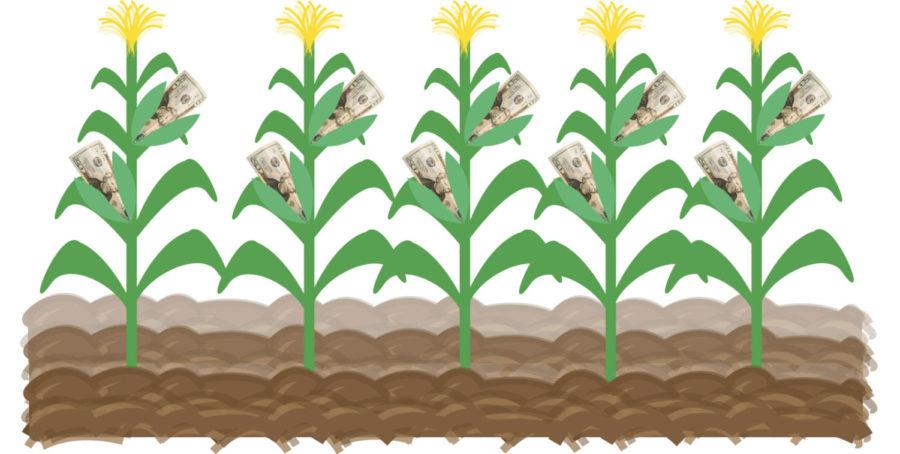Iowa farm land prices high, not a time to worry
Graphic: Kelsey Kremer/Iowa State Daily
Iowa farm land values are at their highest in the state’s history.
January 11, 2012
Farm land values are currently at their highest in Iowa’s history.
Right now, corn is at $6.25 per bushel while soybeans are at $11.70 per bushel. With farmers being able to cash in, the expenses of operation go up as well, including the land value prices.
The reported 2011 state average for all grades of land was estimated at $6,708 per acre, according to Iowa State University Extension Farm Management Specialist and professor of economics Michael Duffy. The report came from the 2011 Iowa Land Value Survey.
This survey has been conducted since 1941 and is sponsored annually by the Iowa Agriculture and Home Economics Experiment Station at Iowa State University. The 2011 Iowa Land Value Survey results are available to view on the Web page for the Iowa State University Extension and Outreach.
“The survey is conducted by licensed real estate brokers and selected informed people around the state who tell us what they think the general trends will be for land,” Duffy said.
Reasons for increase
“There are many reasons as to why land prices are so high,” Duffy said. “The grain prices are high.”
In the overview of survey, Duffy states that the farm net income has been increasing substantially and is projected to increase even more.
“Another factor is that interest rates are as low as they can go,” Duffy said. “Lower interest rates also drive up the amount of people wanting to buy. It’s truly no surprise as to why this is happening.”
According to Duffy, since 2006, farmers have been getting better prices due to the production of ethanol and global sales.
“In 2005, corn prices averaged $1.94 per bushel in Iowa but in November of 2011 corn was projected at $6.05,” according to the survey. “The only year prices weren’t good was in 2009.”
What it means for farmers
With having a percent increase of 32.5 percent from 2010, regardless of the higher grain prices, the most expensive part of the equation for farmers comes down to land price, whether that is buying or renting.
“Well, at my age, I’m not too worried about buying any more land, so the increase doesn’t affect me much on that aspect.” said Bill Hanson, farmer from Sioux City, Iowa, over the phone while unloading a wagon of grain at the Sioux City ADM grain elevator. “I’m also not concerned about the price this year, for I already negotiated my rent price, and it’s locked in. Plus I’ve been renting from the same owners for years.”
For new farmers who have not made those connections with renters, the competition from established farmers such as Hanson, as well as the high land values, make it look less hopeful. The survey also showed that 74 percent of the land sold was to existing farmers, and only 3 percent was sold to new farmers.
“The increasing values mean a lot to me,” said Jacob Petersen, a recent Iowa State graduate with a double degree in animal and dairy science, who is trying to start his own farm. “Not only is it harder to buy land but also to rent land.”
Some advice from Duffy was not to worry. “It has always been this way. If you look back in history, all the way into the ‘20s, a person who wants to get into the farming industry started as the hired hand and worked their way up into ownership. Almost all new farmers first become part of the family operation before branching off and starting their own. As a young person, you just do not have the capital.”
That was also the viewpoint of Hanson. “That’s how I started. I had a job teaching, plus I farmed; that is how a person is going to have to start.”
The reality of the circumstances is nothing new to Derek Rawson, junior in agricultural studies. “As of right now, I can only contribute to the family farm by putting in my time and labor efforts. With going to school and only having part-time jobs, I cannot help out yet financially. After graduating, I plan to have a full-time job to build up my finances while continuing to help out with the family operation.”
This is also the case for Petersen. “I graduated in December of this past year, and I am currently working for Dr. [Kathleen] Delate in the organic ag program at Iowa State. What I want to start is a dairy. I’m in the process of buying a place about 3 miles from my parent’s farm. That way I can continue to help out my dad and older brother on the family operation, while working to make an income and to finance my own operation.”
Is the increase price in the land market a speculative bubble?
When asked what the future holds for the industry regarding the ever increasing land price values, Duffy does not believe that a repeat of the ‘80s farm crisis would occur. “The banks have been pretty conservative about not giving out large loans,” he said. As stated in the overview, debt does not seem to be increasing; however, the longer land values increase, the more potential there is for poorer quality loans.
How to prepare for the future
Dr. William Edwards, professor of agriculture economics, and Dr. Duffy recommended visiting the Ag Decision Maker website to help people make better decisions and to plan for their futures. This site will give them the information and the tools to help them make better business, economic, and financial decisions for farm operations. Ag Decision Maker is available online, through email or people may pay to have a printed subscription.

















